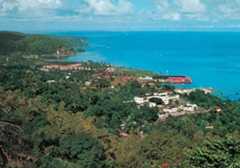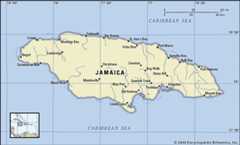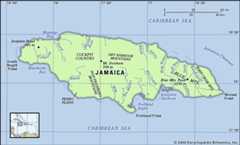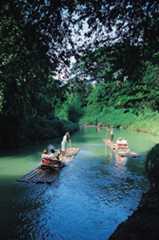Our editors will review what you’ve submitted and determine whether to revise the article.
Economy of Jamaica
Jamaica
Jamaica’s economy is mixed but increasingly based on services, notablytourism and finance. Since independence in 1962, thecountry has developed markedly but unevenly. Mining andmanufacturing became more important to the economy in the latter part of the 20th century, while the export of agriculturalcommodities declined. Starting in the 1980s, the state reduced its role as a major player in the economy, partly because structural adjustment and economic liberalization favoured private enterprise as the engine ofeconomic growth. In the 1990s, however, a financial crisis necessitated government bailouts of some faltering industries and financial institutions.
News•
Agriculture, forestry, and fishing
Agriculture continues to be one of the bases of the island’s economy, accounting for about one-twentieth of thegross domestic product (GDP) and about one-sixth of the workforce. The major crop issugarcane, with its by-products molasses andrum. Fruits, including oranges, coconuts, and bananas, are also important. In the early 21st century, with the end of LoméConvention agreements that had offered a protected market for bananas inBritain, the historically dominant banana industry underwent restructuring to focus on the local market. During the same period, the government sold most of its strugglingsugar enterprises to a Chinese company. Also important are coconuts, squashes,coffee, allspice (pimento), cacao (the source of cocoa beans), tobacco, and ginger. Blue Mountain Coffee, a renowned gourmet brand, is grown on slopes just below 5,000 feet (1,500 metres) and is processed by a select group of Jamaican companies; other types of coffee are grown in the lowlands.Marijuana (ganja) is illegally grown in many areas; however, U.S.-supported antidrug programs havecurtailed its export toNorth America and Europe.
Timber production does not meet the country’s needs, and much of the wood, cork, and paper consumed is imported. The government encourages afforestation. Fishing is a major enterprise, supporting thousands of people. Pedro Bank, part of the island shelf about 60 miles (100 km) southwest of Jamaica, is the main fishing area, but some fishers venture out as far as some 300 miles (500 km); trawling has increasingly damaged Jamaica’s coral reefs.
Resources and power
Large deposits ofbauxite (the ore of aluminum) are found in central Jamaica. Iron ore, gypsum, and marble are in eastern Jamaica, and clays occur in the west. Silica sand and limestone are found throughout the island. Other mineral resources include peat, gravel, and smaller quantities oflignite, copper, lead, zinc, and phosphates; Jamaica’s black sands contain sometitanium.
Mining accounts for just a small fraction of the GDP and of employment, although Jamaica is one of the world’s main producers of bauxite and aluminum. The country’s historical vulnerability to fluctuations in the international economy has beenmanifested in irregular demand and prices on the world aluminum market. U.S. aluminum manufacturers left the island in the 1990s and had been replaced by Russianentrepreneurs by the start of the 21st century. Most of Jamaica’s gypsum is mined for export. Cement is used largely in local construction.
Manufacturing
Manufacturing accounts for roughly one-eighth of the GDP and less than one-tenth of thelabour force. The main products are processed foods (including sugar, rum, and molasses), textiles, and metal products. Printing, chemicals, and cement and clay products are also notable. Import substitution, which had helped the manufacturing industries, was abandoned in the 1980s.
Jamaica imports petroleum for nearly all of its energy needs, includingelectric power generation. Hydroelectric resources and the burning of bagasse (sugarcane residue) generate smaller amounts of electricity. Generators, partly owned by the government, supply most of the electric power, and privately owned facilities provide for the major industries.
Finance
Commercial banks—some of which are subsidiaries of Canadian, British, and U.S. banks—dominate the financial sector. Lifeinsurance companies, building societies, andcredit unions also offer savings and credit services. Thecentral bank is theBank of Jamaica (founded 1960); it issues currency (the Jamaican dollar) and credit and promotes economic development. Several banks and special funding institutions provide loans for industry, housing, tourism, and agriculture.
Jamaica’s government is burdened by a large foreign debt. The Jamaican dollar had a relatively stableexchange rate relative to the U.S. dollar until 1990, when it was floated and radically devalued. In the late 1990s a crisis in the financial sector obliged the government to intervene in the operations of several banks and insurance companies. Remittances from Jamaicans in theUnited States andCanada rivalmining and tourism as Jamaica’s main foreign-exchange earner.
Trade
Tradeconstitutes about one-fourth of the GDP and employs one-sixth of the labour force. The principal exports are aluminum and bauxite, which account for approximately one-third of export earnings; sugar, bananas, coffee, and other agricultural products, beverages and tobacco, and chemicalsconstitute most of the remainder. The United States is, by far, Jamaica’s main trading partner. Canada,Venezuela,Trinidad and Tobago, China, the Netherlands, the United Kingdom, Russia, andMexico are also important trading partners. Jamaica is a participatory member of several trade organizations, including theCaribbean Community (CARICOM).
Services
Finance, tourism, and other services are huge components of the island’s economy, providing about half of both the GDP and employment. Jamaica has attempted to increase its share of the Caribbean region’s burgeoningservice sector by promoting information technologies anddata processing, principally for North American and European companies.
Jamaica’s economy relies heavily on tourism, which has become one of the country’s largest sources of foreign exchange. Significant Spanish investment in the early 21st century joined U.S. and local capital in the tourist sector. Most tourists remain on the island for several days or weeks, although increasing numbers disembark only briefly from cruise ships atOcho Rios,Montego Bay, andFalmouth. Those and other towns on the northern coast, as well as Kingston, are the tourist sector’s main bases of activity. Jamaica is famous for its pleasant climate, fine beaches, and superb scenery, including the waters of Montego Bay and the majesticBlue Mountains.
Labour and taxation
In 1975, legislation provided for conciliation and arbitration procedures which, together with an Industrial Disputes Tribunal, have reduced disharmony in the workplace, especially in the essential services. The establishment of the Jamaica Trade Union Research and Development Centre in the 1980s and the Jamaica Confederation of Trade Unions in 1994 created opportunities fordialogue between trade unions. Each of the largest trade unions isaffiliated with one of the country’s major political parties: the Bustamante Industrial Trade Union (Jamaica Labour Party) and the National Workers’ Union (People’s National Party). There are also employers’ associations. Government revenue is derived mainly fromincome tax, a generalconsumption tax, customs duties, aproperty tax based on the unimproved value of land, stamp duties, and transfers on all real estate transactions.
Transportation
Jamaica’s main roads encircle the island, loop into the valleys, andtraverse the mountains via three major north-south routes, and the Kingstonmetropolitan area has a major public bus system. In 1988 Hurricane Gilbert severely damaged Jamaica’s railway network, contributing to the suspension of passenger services in the 1990s. Four railways transport bauxite from highland mines to coastal refineries and ports.
There are three international airports, two of which—Norman Manley, on the Palisadoes in Kingston, and Donald Sangster, at Montego Bay—are named for former national leaders of Jamaica. The third,Ian Fleming International Airport, near Ocho Rios, is named for the British novelist, who wrote hisJames Bond novels at his house near Oracabessa. Those airports, together with Tinson Pen in Kingston, also handle domestic flights.Port Antonio, Ocho Rios, and Negril have major public airstrips, and there are privately owned airstrips throughout the island. Kingston, Montego Bay, Ocho Rios, and Port Antonio are the principal seaports, handling freighters and large cruise liners. Falmouth also receives cruise liners.















